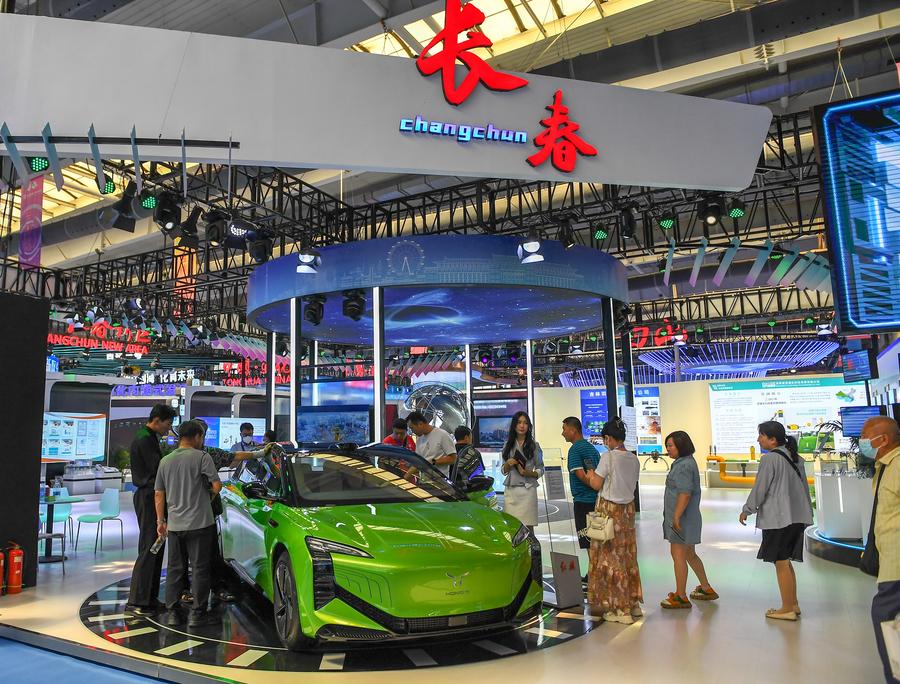New productive forces spurring revival of northeast China

Visitors watch a new-energy car displayed by FAW Hongqi during the 14th China-Northeast Asia Expo in Changchun, northeast China's Jilin Province, Aug. 23, 2023. (Xinhua/Zhang Nan)
HARBIN, March 2 (Xinhua) -- Northeast China is a traditional old industrial base once known as China's "rust belt." Today, the region is sending out strong signals promoting the development of new productive forces to fuel its revival.
In Luobei, a graphite-rich county in Heilongjiang Province, drones with three-dimensional laser technology measure the open-pit mine, electric trucks carry ores down the mountain, and photovoltaic panels produced there help convert solar energy into green electricity.
Wang Jionghui, chairman of a graphite subsidiary of China Minmetals in Heilongjiang, said the company has for the first time applied industrial internet in building a green, intelligent and low-carbon mine with an annual output of 6 million tonnes.
Using cutting-edge technologies such as unmanned trucks, unmanned production, digital management and intelligent control, the county is striving to build a 10-billion-yuan graphite industry cluster.
In September last year, China put forward the concept of new productive forces for the first time. By underscoring this concept, China aims to foster advanced productivity through revolutionary technology breakthroughs, innovative allocation of production factors and deepened industrial upgrading.
Since then, China's northeastern regions have combined their local advantages with cutting-edge technologies to nurture new industries and business models, in an attempt to add further momentum to local transformation and development.
The old industrial base is home to a number of major state-owned enterprises, which are actively using technologies such as 5G and artificial intelligence for industrial upgrading.
In a welding workshop at FAW Hongqi in Jilin Province, over 680 welding robots are busy working, with data collection sensors on them helping to determine in real time the best welding timing.
The Fanrong workshop of FAW Hongqi has also introduced an intelligent central control system, which allows real-time collection and monitoring of equipment data.
Liaoning Province is also ramping up efforts to develop new productive forces, with a focus on strategic emerging and future industries covering new materials, aerospace, robotics, new energy vehicles, integrated circuits, low-altitude economy, artificial intelligence and meta-universe.
"Liaoning has the foundation and advantages to carry out major technological innovation," said Zong Runfu, chairman of semiconductor fabrication equipment maker Kingsemi Co., Ltd.
Top research institutions like the Institute of Metal Research, Dalian Institute of Chemical Physics and Shenyang Institute of Automation, all branches of the Chinese Academy of Sciences, have led the innovative development of Liaoning in new materials, new energy and advanced manufacturing, Zong said.
Heilongjiang Province is also shifting its development focus to strategic emerging industries and future industries.
According to its 2024 government work report, the province announced it will continuously develop strategic emerging industries covering new energy, aerospace, high-end equipment, new materials and biomedicine. It also pledged to nurture future industries including deep space, deep sea and deep Earth.
"Northeast China enjoys a solid foundation for the development of new productive forces," said Sun Haojin, director of the economic research institute of the Heilongjiang Provincial Academy of Social Sciences.
The region has a relatively complete industrial system, a number of leading enterprises, renowned universities and research institutions, and top innovation teams, Sun stated.
To better develop new productive forces in the region, the expert urged to increase research and development spending and push forward the reform and opening-up of the scientific research system and mechanism to boost independent innovation to support industrial development.
Photos
Related Stories
- Special winter enthusiasm in NE China
- Ice and snow tourism propels NE China into high-quality development
- Foreign expats pursue dreams in northeast China's revitalization
- 11 preschoolers become endorsers for winter tourism
- Revitalization of NE China provinces fueled by 1st net resident inflow in over a decade
- Consumption upgrade boosts new productive forces
Copyright © 2024 People's Daily Online. All Rights Reserved.









